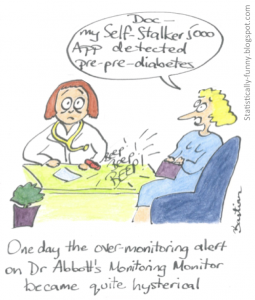Sensor data and the monitored life
The Herald’s has two good stories recently (and other outlets are similar) about new data collection and analysis with smartphone apps. If you read the stories carefully there’s been an outbreak of synecdoche in the newsroom — they are actually stories about new sensors that collect data, and smartphone apps that can be used to monitor the sensors — but that’s a minor detail.
As sensors based on electronics and micromechanics become cheap, it’s easy to collect more and more data. This can be valuable — measuring blood glucose, or pollutants in the air — but it can also get out of hand. Epidemiologist Hilda Bastian gives us this cartoon of the “Self-Stalker 5000” and writes about evidence-based monitoring in her blog at Scientific American
and Nick Alex Harrowell points out
The stereotype application could be defined as “bugging granny”. We’re going to check some metrics at intervals, stick them into a control chart, and then badger you about it.
To be fair, he’s worrying most about sensors that don’t send to a smartphone app, but many of the same principles apply.
Thomas Lumley (@tslumley) is Professor of Biostatistics at the University of Auckland. His research interests include semiparametric models, survey sampling, statistical computing, foundations of statistics, and whatever methodological problems his medical collaborators come up with. He also blogs at Biased and Inefficient See all posts by Thomas Lumley »

I have over 99% confidence that my name isn’t Nick.
Also, no-one ever seems to ask what the false positive rates are like on these things. This is important because overdiagnosis is a thing, because alarms that ring all the time get ignored, because they risk basically reallocating resources from the general population to the (presumptively loud and privileged) minority of worried-well users, and because living in a state of warning-fatigue and self-obsession isn’t good for your mental health (something never mentioned in this context).
Also, the human-factors people are very keen on having fewer beeps and alarms going off on wards, as it conditions the staff to ignore them and generally contributes to background stress and distraction.
It’s now legally possible to have an app approved by the US FDA as a medical device. Because of this, and because of the ruinous lawsuit that will inevitably occur if someone isn’t saved by the heart-attack app, it is absolutely inevitable that they will be tuned to have a much higher false-positive than false-negative rate.
12 years ago